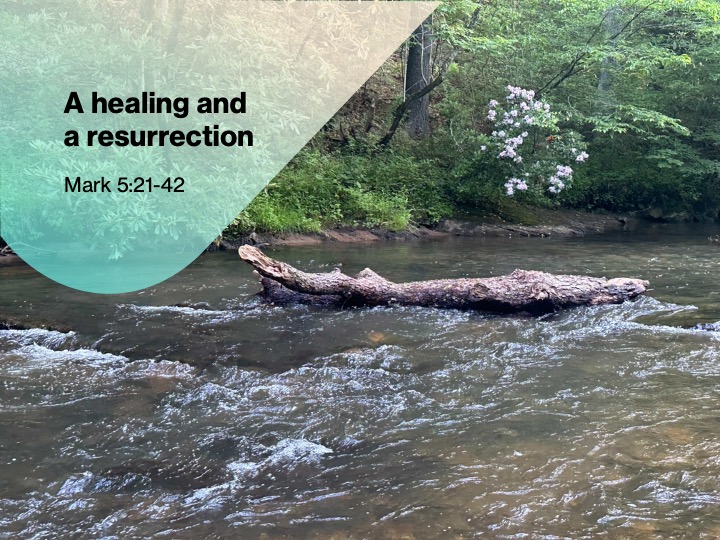Jeff Garrison
Mayberry & Bluemont Churches
June 9, 2024
Mark 5:21-42
At the beginning of worship:
A group of retired men gathered regularly for breakfast and solving the world’s problems. One morning, the day after they had sadly said goodbye to John, who’d been a member of their group, they nursed their coffees and reflected on all the good things said at John’s funeral. Then they began to reflect on the end of their own lives and what might be said of them.
One guy, a retired physician, said he wanted to hear about all the babies he delivered who are now adults. Another, a lawyer wanted to hear about his honesty and hard work to protect those often overlooked within the legal system. A teacher wanted to hear from the students he taught. A contractor wanted to hear about the joy of the homeowners found from those houses he built. Around the table they went.
Everyone had chimed in except for Paul. All eyes turned to him. Finally, Paul shrugged his shoulders and said, “I want to hear someone say, “Look, he’s moving.”
If you caught the weird news of the week, you probably heard about the woman in Nebraska. She had been pronounced dead, her body was picked up, I’m assuming in a body bag, and taken to the funeral home. There, to the surprise of the undertaker, it was discovered she was still breathing.[1]
Our text today contains two miracles: one involves a healing, the other a raising of the dead. The latter, I suggest, is different than misdiagnosing death as happened in Nebraska.
While our Christian hope involves life everlasting, we live out our faith in this life and in these bodies. Even the story of the raising of the dead found in today’s text is more out of a concern for the grieving parents than for the life of the one restored.
Before reading the text:
We have already seen a couple of examples of one of Mark’s favorite literary techniques, the sandwich.[2] This is where Jesus starts with one topic or project, then goes off on a tangent, before returning to the main theme. This happens in our story today. We have a grieving father whose 12-year-old daughter is dying, and an older woman who has been ill for 12 years. Jesus cares for both. Our story can also be found in Matthew and Luke, the other two synoptic gospels.[3]
These stories conclude a set of three set of miracle stories which began with the calming of the waters, followed by the healing of the demoniac. In a way, chapter 5 of Mark’s gospel, while not only including several major miracles, focuses on the ritually unclean. These are desperate people. One commentator suggested that chapter 5 should be the “St. Jude Chapter,” as Jude is considered the “saint’ for lost causes.[4] But Jesus never met a lost cause.
All three of the miracles in chapter 5 require Jesus to ignore the Jewish restrictions. He encounters both the man of the tombs, which made him unclean,[5] as well as the deceased girl and with women with ongoing menstruation. Jesus, whose continually places people over rules, immediately acts to relieve the suffering of others.
Another interesting tidbit about our text comes toward the end. When Jesus awakes the girl who was dead, we’re given the words Jesus used in Aramaic, a later version of Hebrew, along with its translation which was originally in Greek. In most English translation, the Greek is translated, “Little girl, get up,” while the Aramaic words remain as Jesus would have used them. It seems odd to have the original language and a translation, since Hebrew or Aramaic speakers wouldn’t need the translation. This has led some scholars to suggest that Mark is writing to an audience that’s more Gentile than Jewish.[6]
Read Mark 5:21-42
One interesting thing about this text is that, except for the girl’s father, it involves women. In the Old Testament, we have stories of those ill and ritually uncleaned who are healed as well as those dead being restored to life.[7] But they are all men. In the Roman world, women had little status. It was even common for girl infants to be abandoned, kind of like female infants in China during their one child per couple era. While such practice would have been considered an abomination among Jews, for pagan gentiles it would have been less so.
One way the early church set itself apart from the pagan world was to adopt and care for these abandoned children.[8] In his ministry, Jesus showed the value of everyone.
Jesus is now back on the Jewish side of the Sea of Galilee. Unlike on the other side, as we saw last week, where people wanted him gone out of fear, he’s welcomed back on his home turf. Again, as has happened throughout his Galilee ministry, a crowd swarms around Jesus.
Amid the crowd is a leader of the synagogue. He’s probably not a rabbi, but a local lay leader of the synagogue, who took care of the business end of the enterprise.[9] But this also indicates he’s someone of status. The rest of the synagogue has placed him into a position of authority. He’s obviously also one who believes that Jesus has special powers, for his daughter is ill and he comes to Jesus for help. He believes that Jesus’ touch will be enough to save her.
But don’t forget that the crowd presses in on Jesus, so much so that he can hardly move. And while he heads off to help the girl, a woman in need comes and touches his robe. She was someone who had status. She had wealth, but in the past twelve years in which she had bleed, she had spent everything she had on doctors, hoping to find a cure. Now, she’s broke and Jesus is her only hope. She believes that if she can just touch the seam of his robe, she’ll be healed.
This interruption places tension in the story. The girl, we’re told is at death’s door. Jesus needs to come fast to save her. And while the crowd pushed in, Jesus realizes some of his healing power has left him, so he stops and asks who’s touched him.
To the disciples, this is an absurd question. Everyone has been touching Jesus; they can’t help it. It’s like being on a crowded train into Tokyo during rush hour, one of those where the attendants along the tracks push those crowding into the cars to make more room for everyone. But Jesus has felt his healing power leave, so he looks around, and the woman who had reached out to Jesus confesses that she was the one. She’s honest, but also afraid and only confesses with fear and trembling as she knees before Jesus.
Jesus, using endearing words, says, “Daughter, your faith has made you well, go in peace and be healed.”
This interruption has cost precious minutes and now the father of the girl receives word that she died. They advise the father not to bother Jesus anymore. It’s time for him to begin mourning; but Jesus encourages faith and belief as he heads off with the man and the disciples to his home. There, the funeral home has already arrived and begun to arrange things. We can imagine neighbors and members of the synagogue hauling in food while crying out in grief.
You know, one thing about grief is that emotionally we shift around quickly. I’ve known this all along, but it became more evident with my dad’s death.[10] One minute, we’re crying, the next, we’re laughing.
When Jesus asks about the fuss going on and suggests the girl is going to be fine, the gathered crowd goes from grief to laughter. They’ve seen the dead and the dead don’t crawl out of the casket, something Jesus’ ministry will challenge.
The wording here gives us pause to ponder if she was really death. Or perhaps she was like the woman in the Nebraska funeral home. Jesus says, she’s just asleep. But Mark is also making a point that Jesus’ power extends over death, so I take it he means that she is sleeping in the way we speak of the deceased “eternal rest.” Or maybe, as one commentator suggested, he speaks of her asleep to say she’s not “irrevocably dead.”[11]
Taking only his top three disciples—Peter, James and John—along with the parents, Jesus goes inside to where the girl lies. And here, with his words which mean “Little girl, get up” he takes her hand. She rises and walks about. Jesus then tells them not to tell anyone what happened, but to get the girl something to eat. There’s aways a practical side to Jesus!
Mark may have placed these miracle stories—the calming of the waters, the healing of the crazy man, the healing of the woman, and the raising of the girl—back-to-back to point out Jesus’ divinity. But we also learn something else from these stories, especially the one we looked at today.
Jesus is concerned with individual lives and his concern extends even to those sidelined within the Roman world. If Mark, as many suggest, wrote primarily to a Gentile audience, the idea no one is excluded from Jesus’ love is welcome news. And it should be good news to us, too. Amen.
[1] See https://www.usatoday.com/story/news/nation/2024/06/03/nebraska-woman-declared-dead-alive-funeral-home/73964988007/
[2] For examples see Mark 3:20-35. (https://fromarockyhillside.com/2024/04/07/the-unpardonable-sin-baseball-doing-the-will-of-god/) and Mark 4:1-20 (https://fromarockyhillside.com/2024/04/28/the-parable-of-the-sower/).
[3] Matthew 9:18-26 and Luke 8:40-45. Both maintain the “sandwich” structure found in Mark’s gospel. I preached the Luke text in 2022. See https://fromarockyhillside.com/2022/07/17/do-you-have-faith-or-are-you-just-a-spectator/
[4] James R. Edwards, The Gospel According to Mark (Grand Rapids, MI: Eerdmans, 2002),161.
[5] See my sermon on this text: https://fromarockyhillside.com/2024/06/02/jesus-and-the-man-living-in-the-tombs/
[6] Edwards, 167-168.
[7] See 2 Kings 5:1-19, 1 Kings 17:17-24, and 2 Kings 4:18-37.
[8] Douglas R. A. Hare, Westminster Bible Companion: Mark (Louisville, KY: WJKP, 1996), 68.`
[9] Edwards, 161.
[10] https://fromarockyhillside.com/2024/05/11/a-tribute-to-my-dad/
[11] Morna D. Hooker, The Gospel According to Saint Mark (1991, Hendrickson Publishers, 1997), 150.



That’s a beautiful picture of the river. I hope you have a nice week.
Thanks!
I missed that story about the woman in Nebraska. That might not have been unusual 100 years ago, but you’d think pronouncing death these days would be a little more accurate!
Someone in my church suggested that if I ever preach the sermon again, I should title it, “Don’t be embalming no warm bodies” and he then sent me a Youtube clip to a comedian talking about it.